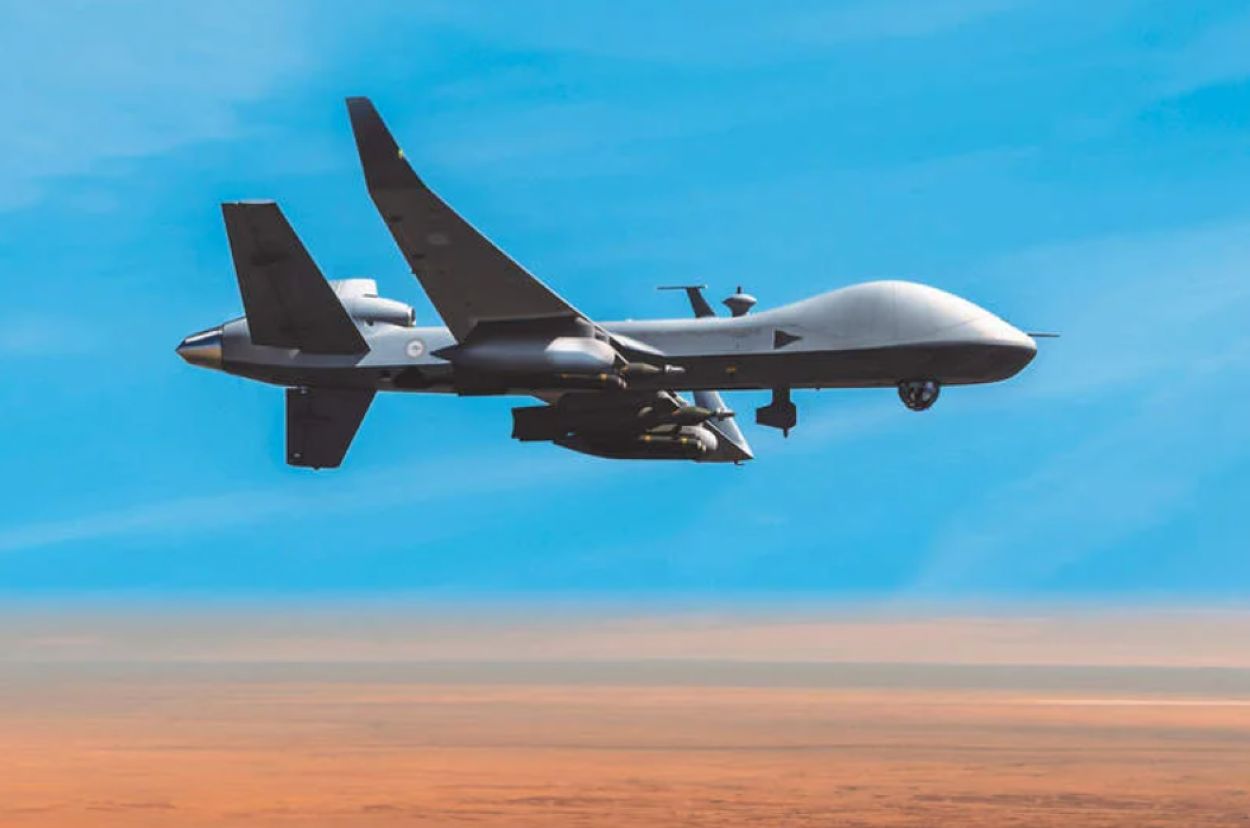India’s military is gearing up for a dynamic duo of drone acquisitions, showcasing its readiness to diversify its aerial capabilities. On one front, India has an indigenous marvel, the Drishti 10 Starliner, while on the other, the eagerly anticipated MQ-9B Reaper from the United States is set to make its mark.
These two acquisitions represent more than just a procurement process; they signify a strategic shift towards embracing a spectrum of specifications, capabilities, and operational methodologies. Delving into the rationale behind this diverse acquisition strategy unveils a tapestry of tactical advantages.
The Indian Army’s existing arsenal boasts the Heron Mark 1 and Mark 2 drones, supplemented by the imminent addition of the Drishti-10, aka Hermes-900 UAVs. These choices, made under the government’s umbrella of emergency procurements greenlit, underline a commitment to bolstering operational efficacy.
Simultaneously, India is set to welcome the MQ-9B armed drones from the US, marking a significant milestone in bilateral defense cooperation. With the US approving the sale of 31 MQ-9B drones, valued at approximately $3.99 billion, this deal holds strategic weight, potentially serving as one of the first major post-election acquisitions for the country.
Anticipation runs high as discussions progress, with deliveries slated to commence in 2027, offering a glimpse into the future of India’s aerial defense landscape.
Drishti 10 / Hermes 900: India’s Eye In The Sky
The Indian Army is gearing up to welcome its first Hermes-900 drone, hailing from Israel, to bolster its watchful gaze along the Pakistan border. Dubbed Drishti-10 on Indian soil, these high-tech UAVs are set to touch down in Hyderabad on May 18.
Crafted by Adani Defence and Aerospace, the Drishti 10 Starliner Unmanned Aerial Vehicle (UAV) boasts more than 60% indigenous composition, signaling a significant stride in India’s defense capabilities. Thanks to a tech-transfer deal inked with Elbit Systems, the brains behind Israel’s drone prowess, this cutting-edge technology is now set to soar over Indian skies.
With the Indian Army snapping up two of these marvels and the Navy securing two for themselves, the Drishti-10 is primed to serve both branches with distinction. Urgently addressing the need for satellite communication-enabled drones, these aerial sentinels are poised to revolutionize surveillance operations.
Armed with advanced Intelligence, Surveillance, and Reconnaissance (ISR) capabilities, the Drishti 10 Starliner is engineered for excellence. With an endurance of 36 hours and 450 kg payload capacity, it’s ready for marathon surveillance missions with no compromises on versatility.
Unlike its counterparts, the Drishti 10 isn’t fazed by Mother Nature’s mood swings. Certified to take on both segregated and unsegregated airspace, it’s a true all-weather warrior. Plus, with NATO’s seal of approval (STANAG 4671), it’s guaranteed to meet the gold standard in international airspace compliance.
Operating at medium altitudes with long-endurance capabilities, the Drishti 10 is a surveillance virtuoso. Whether it’s keeping a vigilant eye over vast stretches of land or maritime domains, this drone is up for the challenge.
Packed with state-of-the-art sensors, next-gen communication systems, and the latest in defense tech, the Drishti 10 Starliner isn’t just a drone—it’s a force multiplier. Get ready to witness the future of Indian defense technology take flight!
When Israel ‘Bombed’ Its Own Drone
According to Israeli military sources, Hezbollah shot down a Hermes 900 drone, marking the first time it managed to kill an advanced system.
“The drone belonging to the Israeli army, which was shot down by the Islamic resistance fighters over Lebanese territory on the evening of Saturday, 6 April 2024, was a Hermes 900,” said Hezbollah.

This was confirmed by the Israeli army’s Arabic spokesperson, Avichay Adraee, who said the UAV had crashed in Lebanese territory after being hit by a surface-to-air missile.
Later on, the Israeli military struck the remains of its Elbit Hermes 900 drone that was shot down by Hezbollah to completely annihilate its sensitive technology, as per experts. In a statement, the IDF said, “The Air Force struck the aircraft earlier today and destroyed it.”
⚡️#BREAKING Hezb-Allah publishes footage of them downing the armed Israeli Hermes 900 drone that was flying in Lebanese airspace pic.twitter.com/yXgaERY8at
— War Monitor (@WarMonitors) April 6, 2024
MQ-9B Reaper: Killer Drones
In a move that’s been brewing for half a decade, India has sealed the deal on acquiring Reaper drones, marking a significant stride in its defense capabilities. The Indian Ministry of Defence gave the green light on June 23, with the US formally approving the MQ-9B drone deal earlier on February 24.
Before these cutting-edge acquisitions, India’s naval prowess was already being bolstered by two SeaGuardian drones, the maritime siblings of the MQ-9B, on lease since 2020. The MQ9-B SkyGuardian ‘hunter-killer’ drones being sold to India will come equipped with advanced surveillance and lethal attack capabilities.
Crafted by the renowned General Atomics Aeronautical Systems, India is set to welcome 31 MQ-9B UAVs into its arsenal, including 15 maritime defenders for the Navy and a squad of eight each for the Army and Air Force.
This elite league of drones currently sees action with the likes of the US forces, NASA, the UK’s Royal Air Force, and esteemed aerial ensembles across Europe. Even Japan has joined the fray, embracing the MQ-9B Sea Guardian drones into its fold.
According to GE’s official website, the MQ-9B stands tall as the premier hunter-killer unmanned aerial vehicle tailored for marathon surveillance missions at dizzying altitudes.
Picture an 11-meter titan with a wingspan stretching over 22 meters, boasting a staggering endurance of over 27 hours and a ceiling of 50,000 feet. Not to mention, it zips through the skies at a brisk 240 Knots True Airspeed (KTAS), effortlessly lugging a payload of up to 1,746 kilograms, including 1,361 kilograms of external armaments.
Equipped with an array of mission payloads ranging from Electro-optical/Infrared (EO/IR) to multimode radars and laser designators, these drones are the Swiss Army knives of aerial surveillance.

Operating this marvel is a two-person crew, with a pilot steering the course and an aircrew maestro orchestrating the sensors and weaponry.
Armored to the teeth, the Reaper flaunts a deadly arsenal capable of unleashing laser-guided missiles and fearsome air-to-ground Hellfire missiles engineered for surgical strikes with minimal collateral damage.
With its endurance, vigilance, and lethal precision, the MQ-9 Reapers promise to elevate India’s Intelligence-Surveillance-Reconnaissance (ISR) game to unprecedented heights.
Drishti 10 Starliner Vs. MQ-9B Reaper
While both drones excel in surveillance capabilities, the main difference lies in their design focus and operational roles.
The Drishti 10 Starliner is more domestically oriented, with a focus on medium-altitude, long-endurance surveillance missions.
On the other hand, the MQ-9B Reaper is a larger, more robust platform designed for extended-duration missions at higher altitudes. It features a higher payload capacity, faster speed, and a wider array of mission payloads, including lethal armaments for precision strikes.
Additionally, the MQ-9B Reaper has a more established presence in global military operations and is recognized as a premier hunter-killer unmanned aerial vehicle.
- Penned By: Shubhangi Palve
- Contact the author at shubhapalve (at) gmail (dot) com




